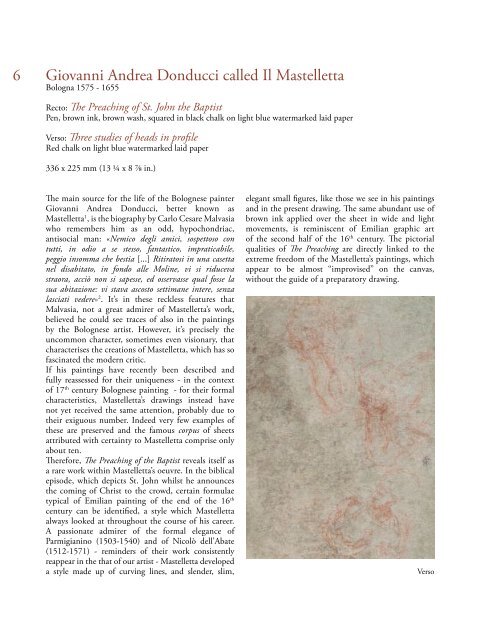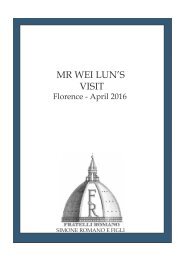A selection of master drawings 2016
- No tags were found...
Create successful ePaper yourself
Turn your PDF publications into a flip-book with our unique Google optimized e-Paper software.
6<br />
Giovanni Andrea Donducci called Il Mastelletta<br />
Bologna 1575 - 1655<br />
Recto: The Preaching <strong>of</strong> St. John the Baptist<br />
Pen, brown ink, brown wash, squared in black chalk on light blue watermarked laid paper<br />
Verso: Three studies <strong>of</strong> heads in pr<strong>of</strong>ile<br />
Red chalk on light blue watermarked laid paper<br />
336 x 225 mm (13 ¼ x 8 ⅞ in.)<br />
The main source for the life <strong>of</strong> the Bolognese painter<br />
Giovanni Andrea Donducci, better known as<br />
Mastelletta 1 , is the biography by Carlo Cesare Malvasia<br />
who remembers him as an odd, hypochondriac,<br />
antisocial man: «Nemico degli amici, sospettoso con<br />
tutti, in odio a se stesso, fantastico, impraticabile,<br />
peggio insomma che bestia [...] Ritiratosi in una casetta<br />
nel disabitato, in fondo alle Moline, vi si riduceva<br />
straora, acciò non si sapesse, ed osservasse qual fosse la<br />
sua abitazione: vi stava ascosto settimane intere, senza<br />
lasciati vedere» 2 . It’s in these reckless features that<br />
Malvasia, not a great admirer <strong>of</strong> Mastelletta’s work,<br />
believed he could see traces <strong>of</strong> also in the paintings<br />
by the Bolognese artist. However, it’s precisely the<br />
uncommon character, sometimes even visionary, that<br />
characterises the creations <strong>of</strong> Mastelletta, which has so<br />
fascinated the modern critic.<br />
If his paintings have recently been described and<br />
fully reassessed for their uniqueness - in the context<br />
<strong>of</strong> 17 th century Bolognese painting - for their formal<br />
characteristics, Mastelletta’s <strong>drawings</strong> instead have<br />
not yet received the same attention, probably due to<br />
their exiguous number. Indeed very few examples <strong>of</strong><br />
these are preserved and the famous corpus <strong>of</strong> sheets<br />
attributed with certainty to Mastelletta comprise only<br />
about ten.<br />
Therefore, The Preaching <strong>of</strong> the Baptist reveals itself as<br />
a rare work within Mastelletta’s oeuvre. In the biblical<br />
episode, which depicts St. John whilst he announces<br />
the coming <strong>of</strong> Christ to the crowd, certain formulae<br />
typical <strong>of</strong> Emilian painting <strong>of</strong> the end <strong>of</strong> the 16 th<br />
century can be identified, a style which Mastelletta<br />
always looked at throughout the course <strong>of</strong> his career.<br />
A passionate admirer <strong>of</strong> the formal elegance <strong>of</strong><br />
Parmigianino (1503-1540) and <strong>of</strong> Nicolò dell’Abate<br />
(1512-1571) - reminders <strong>of</strong> their work consistently<br />
reappear in the that <strong>of</strong> our artist - Mastelletta developed<br />
a style made up <strong>of</strong> curving lines, and slender, slim,<br />
elegant small figures, like those we see in his paintings<br />
and in the present drawing. The same abundant use <strong>of</strong><br />
brown ink applied over the sheet in wide and light<br />
movements, is reminiscent <strong>of</strong> Emilian graphic art<br />
<strong>of</strong> the second half <strong>of</strong> the 16 th century. The pictorial<br />
qualities <strong>of</strong> The Preaching are directly linked to the<br />
extreme freedom <strong>of</strong> the Mastelletta’s paintings, which<br />
appear to be almost “improvised” on the canvas,<br />
without the guide <strong>of</strong> a preparatory drawing.<br />
Verso





